Zichang Liu
Wisdom of Committee: Distilling from Foundation Model to Specialized Application Model
Feb 27, 2024Abstract:Recent advancements in foundation models have yielded impressive performance across a wide range of tasks. Meanwhile, for specific applications, practitioners have been developing specialized application models. To enjoy the benefits of both kinds of models, one natural path is to transfer the knowledge in foundation models into specialized application models, which are generally more efficient for serving. Techniques from knowledge distillation may be applied here, where the application model learns to mimic the foundation model. However, specialized application models and foundation models have substantial gaps in capacity, employing distinct architectures, using different input features from different modalities, and being optimized on different distributions. These differences in model characteristics lead to significant challenges for distillation methods. In this work, we propose creating a teaching committee comprising both foundation model teachers and complementary teachers. Complementary teachers possess model characteristics akin to the student's, aiming to bridge the gap between the foundation model and specialized application models for a smoother knowledge transfer. Further, to accommodate the dissimilarity among the teachers in the committee, we introduce DiverseDistill, which allows the student to understand the expertise of each teacher and extract task knowledge. Our evaluations demonstrate that adding complementary teachers enhances student performance. Finally, DiverseDistill consistently outperforms baseline distillation methods, regardless of the teacher choices, resulting in significantly improved student performance.
Heterogeneous federated collaborative filtering using FAIR: Federated Averaging in Random Subspaces
Nov 03, 2023Abstract:Recommendation systems (RS) for items (e.g., movies, books) and ads are widely used to tailor content to users on various internet platforms. Traditionally, recommendation models are trained on a central server. However, due to rising concerns for data privacy and regulations like the GDPR, federated learning is an increasingly popular paradigm in which data never leaves the client device. Applying federated learning to recommendation models is non-trivial due to large embedding tables, which often exceed the memory constraints of most user devices. To include data from all devices in federated learning, we must enable collective training of embedding tables on devices with heterogeneous memory capacities. Current solutions to heterogeneous federated learning can only accommodate a small range of capacities and thus limit the number of devices that can participate in training. We present Federated Averaging in Random subspaces (FAIR), which allows arbitrary compression of embedding tables based on device capacity and ensures the participation of all devices in training. FAIR uses what we call consistent and collapsible subspaces defined by hashing-based random projections to jointly train large embedding tables while using varying amounts of compression on user devices. We evaluate FAIR on Neural Collaborative Filtering tasks with multiple datasets and verify that FAIR can gather and share information from a wide range of devices with varying capacities, allowing for seamless collaboration. We prove the convergence of FAIR in the homogeneous setting with non-i.i.d data distribution. Our code is open source at {https://github.com/apd10/FLCF}
Deja Vu: Contextual Sparsity for Efficient LLMs at Inference Time
Oct 26, 2023Abstract:Large language models (LLMs) with hundreds of billions of parameters have sparked a new wave of exciting AI applications. However, they are computationally expensive at inference time. Sparsity is a natural approach to reduce this cost, but existing methods either require costly retraining, have to forgo LLM's in-context learning ability, or do not yield wall-clock time speedup on modern hardware. We hypothesize that contextual sparsity, which are small, input-dependent sets of attention heads and MLP parameters that yield approximately the same output as the dense model for a given input, can address these issues. We show that contextual sparsity exists, that it can be accurately predicted, and that we can exploit it to speed up LLM inference in wall-clock time without compromising LLM's quality or in-context learning ability. Based on these insights, we propose DejaVu, a system that uses a low-cost algorithm to predict contextual sparsity on the fly given inputs to each layer, along with an asynchronous and hardware-aware implementation that speeds up LLM inference. We validate that DejaVu can reduce the inference latency of OPT-175B by over 2X compared to the state-of-the-art FasterTransformer, and over 6X compared to the widely used Hugging Face implementation, without compromising model quality. The code is available at https://github.com/FMInference/DejaVu.
Scissorhands: Exploiting the Persistence of Importance Hypothesis for LLM KV Cache Compression at Test Time
May 26, 2023



Abstract:Large language models(LLMs) have sparked a new wave of exciting AI applications. Hosting these models at scale requires significant memory resources. One crucial memory bottleneck for the deployment stems from the context window. It is commonly recognized that model weights are memory hungry; however, the size of key-value embedding stored during the generation process (KV cache) can easily surpass the model size. The enormous size of the KV cache puts constraints on the inference batch size, which is crucial for high throughput inference workload. Inspired by an interesting observation of the attention scores, we hypothesize the persistence of importance: only pivotal tokens, which had a substantial influence at one step, will significantly influence future generations. Based on our empirical verification and theoretical analysis around this hypothesis, we propose Scissorhands, a system that maintains the memory usage of the KV cache at a fixed budget without finetuning the model. In essence, Scissorhands manages the KV cache by storing the pivotal tokens with a higher probability. We validate that Scissorhands reduces the inference memory usage of the KV cache by up to 5X without compromising model quality. We further demonstrate that Scissorhands can be combined with 4-bit quantization, traditionally used to compress model weights, to achieve up to 20X compression.
Learning Multimodal Data Augmentation in Feature Space
Dec 29, 2022



Abstract:The ability to jointly learn from multiple modalities, such as text, audio, and visual data, is a defining feature of intelligent systems. While there have been promising advances in designing neural networks to harness multimodal data, the enormous success of data augmentation currently remains limited to single-modality tasks like image classification. Indeed, it is particularly difficult to augment each modality while preserving the overall semantic structure of the data; for example, a caption may no longer be a good description of an image after standard augmentations have been applied, such as translation. Moreover, it is challenging to specify reasonable transformations that are not tailored to a particular modality. In this paper, we introduce LeMDA, Learning Multimodal Data Augmentation, an easy-to-use method that automatically learns to jointly augment multimodal data in feature space, with no constraints on the identities of the modalities or the relationship between modalities. We show that LeMDA can (1) profoundly improve the performance of multimodal deep learning architectures, (2) apply to combinations of modalities that have not been previously considered, and (3) achieve state-of-the-art results on a wide range of applications comprised of image, text, and tabular data.
DONet: Learning Category-Level 6D Object Pose and Size Estimation from Depth Observation
Jun 27, 2021

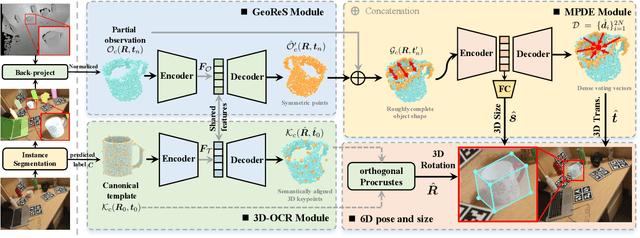

Abstract:We propose a method of Category-level 6D Object Pose and Size Estimation (COPSE) from a single depth image, without external pose-annotated real-world training data. While previous works exploit visual cues in RGB(D) images, our method makes inferences based on the rich geometric information of the object in the depth channel alone. Essentially, our framework explores such geometric information by learning the unified 3D Orientation-Consistent Representations (3D-OCR) module, and further enforced by the property of Geometry-constrained Reflection Symmetry (GeoReS) module. The magnitude information of object size and the center point is finally estimated by Mirror-Paired Dimensional Estimation (MPDE) module. Extensive experiments on the category-level NOCS benchmark demonstrate that our framework competes with state-of-the-art approaches that require labeled real-world images. We also deploy our approach to a physical Baxter robot to perform manipulation tasks on unseen but category-known instances, and the results further validate the efficacy of our proposed model. Our videos are available in the supplementary material.
Efficient Inference via Universal LSH Kernel
Jun 21, 2021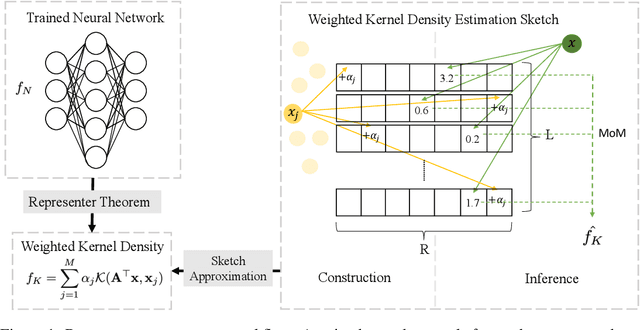

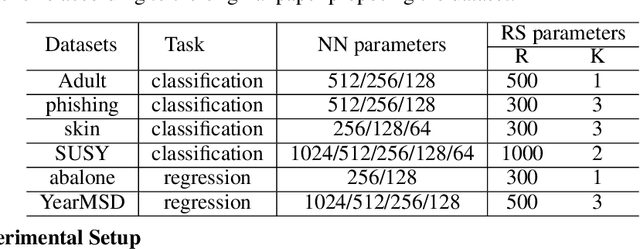
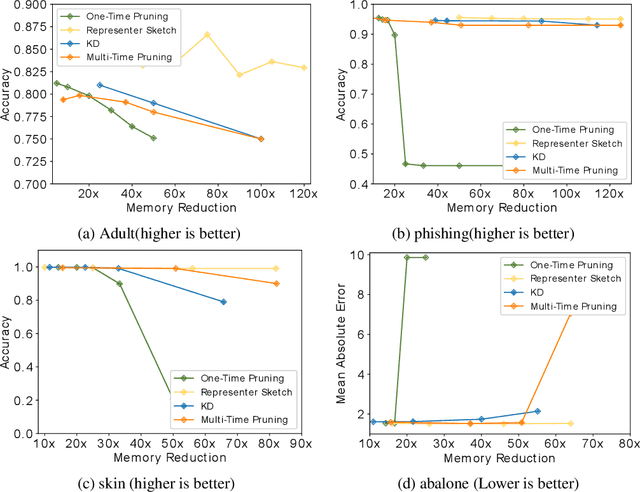
Abstract:Large machine learning models achieve unprecedented performance on various tasks and have evolved as the go-to technique. However, deploying these compute and memory hungry models on resource constraint environments poses new challenges. In this work, we propose mathematically provable Representer Sketch, a concise set of count arrays that can approximate the inference procedure with simple hashing computations and aggregations. Representer Sketch builds upon the popular Representer Theorem from kernel literature, hence the name, providing a generic fundamental alternative to the problem of efficient inference that goes beyond the popular approach such as quantization, iterative pruning and knowledge distillation. A neural network function is transformed to its weighted kernel density representation, which can be very efficiently estimated with our sketching algorithm. Empirically, we show that Representer Sketch achieves up to 114x reduction in storage requirement and 59x reduction in computation complexity without any drop in accuracy.
Neighbor Oblivious Learning (NObLe) for Device Localization and Tracking
Nov 23, 2020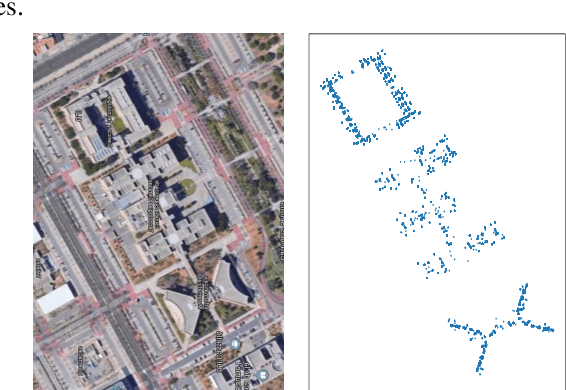

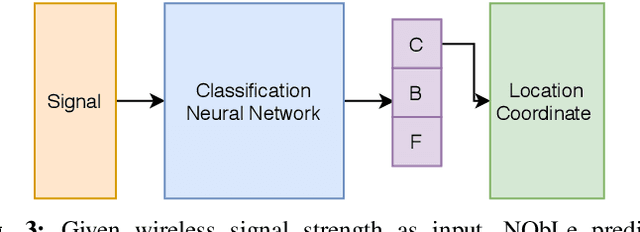

Abstract:On-device localization and tracking are increasingly crucial for various applications. Along with a rapidly growing amount of location data, machine learning (ML) techniques are becoming widely adopted. A key reason is that ML inference is significantly more energy-efficient than GPS query at comparable accuracy, and GPS signals can become extremely unreliable for specific scenarios. To this end, several techniques such as deep neural networks have been proposed. However, during training, almost none of them incorporate the known structural information such as floor plan, which can be especially useful in indoor or other structured environments. In this paper, we argue that the state-of-the-art-systems are significantly worse in terms of accuracy because they are incapable of utilizing these essential structural information. The problem is incredibly hard because the structural properties are not explicitly available, making most structural learning approaches inapplicable. Given that both input and output space potentially contain rich structures, we study our method through the intuitions from manifold-projection. Whereas existing manifold based learning methods actively utilized neighborhood information, such as Euclidean distances, our approach performs Neighbor Oblivious Learning (NObLe). We demonstrate our approach's effectiveness on two orthogonal applications, including WiFi-based fingerprint localization and inertial measurement unit(IMU) based device tracking, and show that it gives significant improvement over state-of-art prediction accuracy.
Conditional Automated Channel Pruning for Deep Neural Networks
Sep 27, 2020

Abstract:Model compression aims to reduce the redundancy of deep networks to obtain compact models. Recently, channel pruning has become one of the predominant compression methods to deploy deep models on resource-constrained devices. Most channel pruning methods often use a fixed compression rate for all the layers of the model, which, however, may not be optimal. To address this issue, given a target compression rate for the whole model, one can search for the optimal compression rate for each layer. Nevertheless, these methods perform channel pruning for a specific target compression rate. When we consider multiple compression rates, they have to repeat the channel pruning process multiple times, which is very inefficient yet unnecessary. To address this issue, we propose a Conditional Automated Channel Pruning(CACP) method to obtain the compressed models with different compression rates through single channel pruning process. To this end, we develop a conditional model that takes an arbitrary compression rate as input and outputs the corresponding compressed model. In the experiments, the resultant models with different compression rates consistently outperform the models compressed by existing methods with a channel pruning process for each target compression rate.
Climbing the WOL: Training for Cheaper Inference
Jul 03, 2020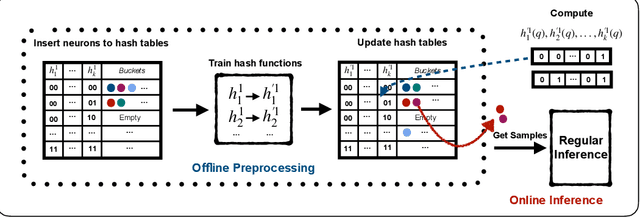
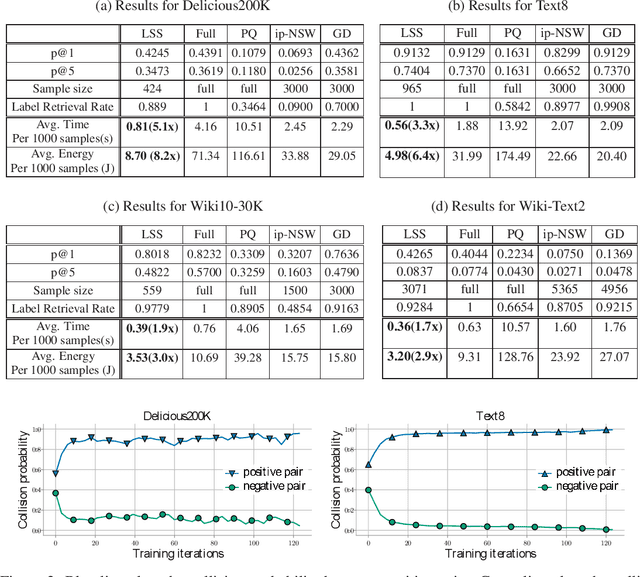


Abstract:Efficient inference for wide output layers (WOLs) is an essential yet challenging task in large scale machine learning. Most approaches reduce this problem to approximate maximum inner product search (MIPS), which relies heavily on the observation that for a given model, ground truth labels correspond to logits of highest value during full model inference. However, such an assumption is restrictive in practice. In this paper, we argue that approximate MIPS subroutines, despite having sub-linear computation time, are sub-optimal because they are tailored for retrieving large inner products with high recall instead of retrieving the correct labels. With WOL, the labels often have moderate inner products, which makes approximate MIPS more challenging. We propose an alternative problem formulation, called Label Superior Sampling (LSS), where the objective is to tailor the system to ensure retrieval of the correct label. Accordingly, we propose a novel learned hash approach, which is significantly more efficient and sufficient for high inference accuracy than MIPS baselines. Our extensive evaluation indicates that LSS can match or even outperform full inference accuracy with around 5x speed up and 87% energy reduction.
 Add to Chrome
Add to Chrome Add to Firefox
Add to Firefox Add to Edge
Add to Edge